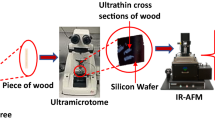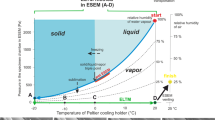Abstract
The surface properties of the plant cuticle play a crucial role in plant–pathogen interactions and the retention and penetration of agriculturally important chemicals. This paper describes the use of X-ray photoelectron spectroscopy (XPS), time-of-flight secondary-ion mass spectrometry (ToF-SIMS), tapping-mode atomic force microscopy (TM-AFM) and scanning electron microscopy (SEM) to determine surface-specific chemical and material properties of the adaxial surface of Prunus laurocerasus L. leaves. XPS data, derived from the uppermost few nanometres (<10 nm) of the leaf surface, were consistent with the wax components and functionality known to be present within the waxes. ToF-SIMS provided molecular speciation from the outermost monolayer of the leaf surface, indicating the importance of a family of acetates with chain lengths ranging from C20 to C34. The presence of alkanes with C29 and C31 chain lengths was also confirmed. SEM and TM-AFM topography images revealed a textured granular surface, while simultaneously recorded AFM phase images revealed heterogeneous material properties at the nanoscale. The relevance of these data to plant cuticle development, allelochemistry and agrochemical delivery is discussed.








Similar content being viewed by others
Abbreviations
- AFM :
-
Atomic force microscopy
- A–P–D :
-
Amplitude–phase–distance
- BE :
-
Binding energy
- CW :
-
Cuticular wax
- EW :
-
Epicuticular wax
- FE-SEM :
-
Field-emission scanning electron microscopy
- SEM :
-
Scanning electron microscopy
- TM-AFM :
-
Tapping-mode atomic force microscopy
- ToF-SIMS :
-
Time-of-flight secondary-ion mass spectrometry
- UHV :
-
Ultra high vacuum
- XPS :
-
X-ray photoelectron spectroscopy
References
Baker EA (1982) Chemistry and morphology of plant epicuticular waxes. In: Cutler D, Alvin K, Price C (eds) The plant cuticle. Academic Press, London, pp 139–166
Barthlott W, Neinhuis C, Cutler D, Ditsch F, Meusel I, Theisen I, Wilhelmi H (1998) Classification and terminology of plant epicuticular waxes. Bot J Linn Soc 126:237–260
Brewis DM, Briggs D, Dahm RH, Fletcher I (2000) A ToF-SIMS study of electrochemical pretreatments for polymers. Surf Interface Anal 29:572–581
Briggs D, Fairley N (2002) XPS of chemically modified low-density polyethylene surfaces: observations on curve-fitting the C 1s spectrum. Surf Interface Anal 33:283–290
Briggs D, Grant JT, eds (2003) Surface analysis by Auger and X-ray photoelectron spectroscopy. Surface Spectra/IM Publications, Manchester
Briggs D, Brewis DM, Dahm RH, Fletcher IH (2003) Analysis of the surface chemistry of oxidized polyethylene: comparison of XPS and ToF-SIMS. Surf Interface Anal 35:156–167
Canet D, Rohr R, Chamel A, Guillain F (1996) Atomic force microscopy study of isolated ivy leaf cuticles observed directly and after embedding in Epon(R). New Phytol 134:571–577
Carver T, Thomas B (1990) Normal germling development by Erysiphe graminis on cereal leaves freed of epicuticular wax. Plant Pathol 39:367–375
Carver T, Thomas B, Ingerson-Morris S, Roderick H (1990) The role of the abaxial leaf surface waxes Lolium spp. in resistance to Erysiphe graminis. Plant Pathol 39:573–583
Chen X, Davies MC, Roberts CJ, Tendler SJB, Williams PM, Davies J, Dawkes AC, Edwards JC (1998) Interpretation of tapping mode atomic force microscopy data using amplitude-phase-distance measurements. Ultramicroscopy 75:171–181
Chen X, Davies MC, Roberts CJ, Tendler SJB, Williams PM, Burnham NA (2000) Optimizing phase imaging via dynamic force curves. Surf Sci 460:292–300
Chen X, Roberts CJ, Zhang J, Davies MC, Tendler SJB (2002) Phase contrast and attraction–repulsion transition in tapping mode atomic force microscopy. Surf Sci 519: L593–L598
Danesh A, Chen X, Davies MC, Roberts CJ, Sanders GHW, Tendler SJB, Williams PM, Wilkins MJ (2000a) Polymorphic discrimination using atomic force microscopy: distinguishing between two polymorphs of the drug cimetidine. Langmuir 16:866–870
Danesh A, Chen X, Davies MC, Roberts CJ, Sanders GHW, Tendler SJB, Williams PM, Wilkins MJ (2000b) The discrimination of drug polymorphic forms from single crystals using atomic force microscopy. Pharm Res 17:887–890
Deleuze M, Denis JP, Delhalle J, Pickup BT (1993) Theoretical-study of spectral differences in the XPS valence bands of polyethylene lamellae and films. J Phys Chem 97:5115–5123
Ensikat HJ, Neinhuis C, Barthlott W (2000) Direct access to plant epicuticular wax crystals by a new mechanical isolation method. Int J Plant Sci 161:143–148
Flaishman MA, Hwang CS, Kolattukudy PE (1995) Involvement of protein phosphorylation in the induction of appressorium formation in Colletotrichum gloeosporioides by its host surface wax and ethylene. Physiol Mol Plant 47:103–117
Holloway PJ (1993) Structure and histochemistry of plant cuticles. Pestic Sci 37:203–232
Holloway PJ (1984) Surface lipids of plants and animals. In: Mangold HK, Zweig G, Sherma J (eds) Handbook of chromatography. Lipids vol 1. CRC Press, Boca Raton
Jeffree C (1996) Structure and ontogeny of plant cuticles. In: Kerstiens G (ed) Plant cuticles: an integrated functional approach. BIOS, Oxford, pp 33–82
Jetter R, Schaffer S (2001) Chemical composition of the Prunus laurocerasus leaf surface. Dynamic changes of the epicuticular wax film during leaf development. Plant Physiol 126:1725–1737
Jetter R, Schaffer S, Riederer M (2000) Leaf cuticular waxes are arranged in chemically and mechanically distinct layers: evidence from Prunus laurocerasus L. Plant Cell Environ 23:619–628
Kerstiens G (1996) Signalling across the divide: a wider perspective of cuticular structure–function relationships. Trends Plant Sci 1:125–129
Knapp HF, Stemmer A (1999) Preparation, comparison and performance of hydrophobic AFM tips. Surf Interface Anal 27:324–331
Magonov SN, Cleveland J, Elings V, Denley D, Whangbo MH (1997) Tapping-mode atomic force microscopy study of the near-surface composition of a styrene–butadiene–styrene triblock copolymer film. Surf Sci 389:201–211
Mechaber WL, Marshall DB, Mechaber RA, Jobe RT, Chew FS (1996) Mapping leaf surface landscapes. Proc Natl Acad Sci USA 93:4600–4603
Müller A (1927) An X-ray investigation of certain long chain compounds. Proc R Soc Lond Ser A 114:5 42–561
Müller A (1928) A further X-ray investigation of long chain compounds. Proc R Soc Lond Ser A 120: 437–459
Podila GK, Rogers LM, Kolattukudy PE (1993) Chemical signals from advocado surface wax trigger germination in and appressorium formation in Colletotrichum gloeosporioides. Plant Physiol 103:267–272
Riederer M, Schreiber L (2001) Protecting against water loss: analysis of the barrier properties of plant cuticles. J Exp Bot 52:2023–2032
Santier S, Chamel A (1996) Penetration of triolein and methyl oleate through isolated plant cuticles and their effect on penetration of C-14 quizalofop-ethyl and C-14 fenoxaprop-ethyl. Weed Res 36:167–174
Santier S, Chamel A (1998) Reassessment of the role of cuticular waxes in the transfer of organic molecules through plant cuticles. Plant Physiol Biochem 36:225–231
Schönherr J, Riederer M (1986) Plant cuticles sorb lipophilic compounds during enzymatic isolation. Plant Cell Environ 9:459–466
Schoonhoven LM, Jermy T, van Loon J (1998) Insect-plant biology: from physiology to evolution. London, Chapman and Hall
Shao ZF, Mou J, Czajkowsky DM, Yang J, Yuan JY (1996) Biological atomic force microscopy: what is achieved and what is needed. Adv Phys 45:1–86
Sylwia K, Wisniewska SK, Nalaskowski J, Witka-Jezewska E, Hupka J, Miller JD (2003) Surface properties of barley straw. Colloid Surf B 29:131–142
Vansteenkiste SO, Davies MC, Roberts CJ, Tendler SJB (1998) Scanning probe microscopy of biomedical interfaces. Prog Surf Sci 57:95–136
Verma AR (1955) Interferometric and X-ray investigations of the growth of long chain fatty acid crystals. I. Polymorphism and polytypism in palmitic acid crystals. Proc R Soc Lond Ser A 228:34–49
Vickerman JC, Briggs D (2001) ToF-SIMS: Surface analysis by mass spectrometry. Surface Spectra/IM publications, Manchester
Vickerman JC, Briggs D, Henderson A, eds (2002) The static SIMS library, version 3. SurfaceSpectra Ltd., PO Box 378, Manchester, M60 2LQ, UK
Walton T (1990) Waxes, cutin and suberin. In: Harwood L, Bowyer J (ed) Lipids, membranes and aspects of photobiology. Academic Press, London, pp 131–155
Zhang JX, Busby AJ, Roberts CJ, Chen XY, Davies MC, Tendler SJB, Howdle SM (2002) Preparation of a poly(methyl methacrylate)/ultrahigh molecular weight polyethylene blend using supercritical carbon dioxide and the identification of a three-phase structure: an atomic force microscopy study. Macromolecules 35:8869–8877
Zhong Q, Inniss D, Kjoller K, Elings VB (1993) Fractured polymer silica fiber surface studied by tapping mode atomic-force microscopy. Surf Sci 290:L688–L692
Acknowledgements
The authors thank Syngenta Ltd. and The University of Nottingham for funding a studentship for M. Perkins. We also thank Emily Smith for assistance with the XPS data and Frank Rutten for the ToF-SIMS data.
Author information
Authors and Affiliations
Corresponding author
Rights and permissions
About this article
Cite this article
Perkins, M.C., Roberts, C.J., Briggs, D. et al. Surface morphology and chemistry of Prunus laurocerasus L. leaves: a study using X-ray photoelectron spectroscopy, time-of-flight secondary-ion mass spectrometry, atomic-force microscopy and scanning-electron microscopy. Planta 221, 123–134 (2005). https://doi.org/10.1007/s00425-004-1417-0
Received:
Accepted:
Published:
Issue Date:
DOI: https://doi.org/10.1007/s00425-004-1417-0




